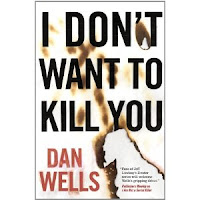Wells, D. (2010). Mr. Monster. New York: Tor.
Appetizer: Things have calmed down since the events of I Am Not a Serial Killer. There haven't been any more murders and the people in Clayton are starting to relax. Even though John knew the fate of the killer before anyone else, he's still having his own problems. He broke down the wall that kept his dark impulses under control. Mr. Monster is out now and is urging John to do more violence.
But then, another body, a girl this time, is found and it looks like the town has another killer. John fears that the dead girl is a message. A message for him.
He must deal with the new killer, with trying to keep Mr. Monster in check and, most surprisingly of all, going on a date with a neighbor girl, Brooke, the girl he has been trying to control his obsession with for months.
I really liked John's struggle with trying to date Brooke. It was a good challenge for John.
*Spoiler for mid-book in this paragraph* I also liked the drama involving John's sister, who is dating an abusive egotistical guy who reminds John of his father. It was an interesting trigger for John's murderous impulses and for insights into the family's past. Although, after John sees a bruise on his sister's face and has to vent his anger, I really hated who is hurt by John's rage. It was a sad enough scene that I almost wanted to stop reading. *End spoiler*
I have to admit, Mr. Monster included a lot of dark aspects that won't be for every reader. Reader, be warned.
The third and final book in this trilogy, I Don't Want to Kill You, will be out at the end of March. You can pretty much count on the fact that I will be picking it up, wanting to know what happens to John and his many demons.
Yet again, I am left feeling like I know way too much about human embalming. I am off to read a book that involves less death. *glances around at YA dystopian, vampire and zombie trends* Assuming there are any light books left out there.
Dinner Conversation:
"I want to do a lot of terrible things, and it's just easier to come to terms with that side of me by pretending it's someone else--it's not John who wants to cut his mother into tiny pieces, it's Mr. Monster. See? I feel better already.
But here's the problem: Mr. Monster is hungry. Serial killers often talk about a need--some driving urge that they can control at first, but that builds and builds until it's impossible to stop, and then they lash out and kill again. I never understood what they were talking about before, but now I think I do. Now I can feel it, deep in my bones, as insistent and inevitable as the biological urge to eat or hunt or mate.
I've killed once, and it's only a matter of time before I kill again." (p. 12).
"For my sixteenth birthday I got a dead body to play with: Mrs. Soder, the oldest woman in Clayton County, finally died. The corpse was laid out on the stainless steel embalming table, the body bag removed and the body motionless. It had died in the hospital, and they'd shipped it to us in a hospital gown. This made it a lot easier; rather than wrestle with real clothes, or try to get the family's permission to cut them off, we could just snip a tie here and there and have the hospital gown off in seconds. The embalming would be almost too easy--I wanted to take as much time as possible, so I could really enjoy it" (p. 76).
"For me, embalming was a form of medication; it brought a sense of peace that I had never found in any other aspect of my life. I loved the stillness of it, the quietness. The bodies never moved or yelled; they night fought or left. The dead simply lay there, at peace with the world, and let me do whatever I needed to do. I was in control of myself.
I was in control of them." (p. 79).
"They found the second woman's body on Saturday, lying in a ditch on Route 12, covered with a similar array of torture wounds. It was the same place where the Clayton Killer's second victim was found, less than ten feet from the exact spot. It was now obvious that this new killer was trying to communicate something, but what? Was he saying "I'm the same," or "I'd different"? Was he telling us he wanted to be like the first killer, or was he hinting that he already was? More than anything else, I wondered who he was talking to: the police? The whole community? Or was he sending this message to the only other killer in town?
Was he talking to me?" (p. 87).
Tasty Rating: !!!



No comments:
Post a Comment